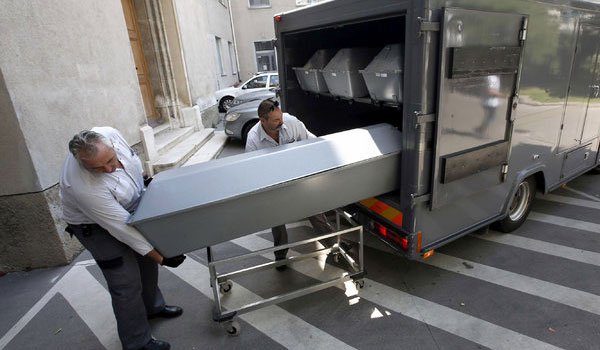The authorities in Austria and Hungary said at least four people had been arrested in connection with the truck. They also disclosed that the remains of 71 people had been found inside, including four children, and that at least some had come from Syria. On Thursday, officials estimated as many as 50 people had been packed in the vehicle, before they discovered additional bodies.
The migrant crisis, the biggest wave to hit Europe since World War II, was further amplified on Friday by a report from the United Nations refugee agency estimating a 40 percent jump this year in the number of people fleeing to the Continent by boat compared with all of 2014. Most are escaping war and strife in the Middle East and Africa.
Secretary General Ban Ki-moon of the United Nations, expressing shock over the latest deaths, announced an emergency summit Sept. 30 in New York while world leaders are visiting for the annual General Assembly. He called Europe’s migrant crisis a reflection of deeper travails elsewhere and cited the Syria war as an example, saying that conflict had “just been manifested on a roadside in the heart of Europe.”
The deadly perils of crossing the Mediterranean, already well known, were reinforced by news from Libyan and international relief officials that 150 people had drowned off western Libya after their boats sank on Thursday.
The exact toll was unclear, but potentially was among the highest this summer for the desperate families trying to reach European shores.
Jamal Naji Zubia, director of the foreign media office for the Tripoli-based government of Libya, said the victims drowned near the western port city of Zuwarah, near the Tunisian border, a frequently used departure point for migrants and refugees often in packed fishing boats or rubber dinghies.
In Sicily, Italian officials announced the arrests of 10 suspected smugglers implicated in the deaths of at least 52 people who had suffocated in the hold of an overcrowded boat found on Wednesday. Maurizio Scalia, a prosecutor in Palermo, was quoted by Agence France-Presse as saying the arrests were based on statements of survivors who said “the victims were all violently forced to stay below deck in an awful condition.”
Still, much of the focus in Europe on Friday was on the relatively new danger of death from smuggling overland, crystallized by the mystery of the people found in the abandoned truck in Austria.
The authorities there reported that three boys ages 7 to 10 and a toddler girl were among the 71 people decomposing in the truck, which had no ventilation, abandoned east of Vienna on Wednesday and discovered 24 hours later. The other passengers included 59 men and eight women.
Officials at Hyza, the Slovakian company that formerly owned the truck, said its cooling system was not functional when they sold it. Austrian authorities said they had determined the truck lacked ventilation.
The United Nations refugee agency report said the number of refugees and migrants crossing the Mediterranean to reach Europe had reached 310,000 this year, up from 219,000 in 2014.
Close to 200,000 people have landed in Greece this year and about 110,000 more have reached Italy, Melissa Fleming, a spokeswoman for the refugee agency told reporters in Geneva.
More than 2,500 people have died at sea this year, not including those believed to be victims in Thursday’s sinking off Libya. Last year, 3,500 died or were lost while trying to cross the Mediterranean to Europe.
“The way people are being packed onto boats is causing their deaths,” Ms. Fleming said.
At the root of many of the deaths are the practices of human traffickers who overload boats, cars, trucks and vans.
The Austrian authorities believe that is what happened to the migrants whose corpses were discovered in the truck, parked in the emergency lane of a highway southeast of Vienna.
Once investigators opened the rear hold of the vehicle, said Hans Peter Doskozil, director of police in the eastern Austrian state of Burgenland, they found more corpses than expected.
They were trying to identify the victims and established a hotline for anyone seeking information about missing relatives.
While the authorities said it was premature to give an exact cause of death, they noted the absence of ventilation, the broken refrigeration system and the dent in the vehicle’s side, raising the possibility it had been caused by occupants trying to escape or seek fresh air.
“We cannot say whether air was able to circulate through the cooling system or the roof,” Mr. Doskozil said, “but I believe that it is highly likely that people in this truck asphyxiated.”
The authorities said on Friday that three Bulgarians and an Afghan suspected of involvement in the truck operation had been detained in Hungary.
In a separate case, 10 Syrian migrants were injured early Friday when a van overturned on a highway in Hungary, the police said in a statement.
The Austrian Red Cross said it expected as many as 4,000 people to cross the country’s eastern border over the weekend, and the authorities said they would increase controls. They emphasized, however, that they would not be able to stop each of the thousands of trucks that enter from the east every day.
The migrants found dead in Austria most likely followed a now-popular route from Greece, through the Balkans and Hungary, and toward the north.
Hungary reported a daily average of 2,000 people cross its border with Serbia, but on Wednesday the number rose to 3,241 people, including 700 children — the highest number in a single day recorded this year, the United Nations refugee agency reported.
In a bid to deter the flow of refugees, Hungary has accelerated construction of a fence along its border with Serbia, but humanitarian-agency officials in Geneva described it as “a roundabout subsidy to the smugglers,” who charge refugees and migrants more money to get them past it.
Building walls “looks tough, it looks proactive, it looks as if you’re taking people’s complaints seriously that there are too many migrants,” said Joel Millman, a spokesman for the International Organization for Migration. “It doesn’t work.”
(nytimes.com)






